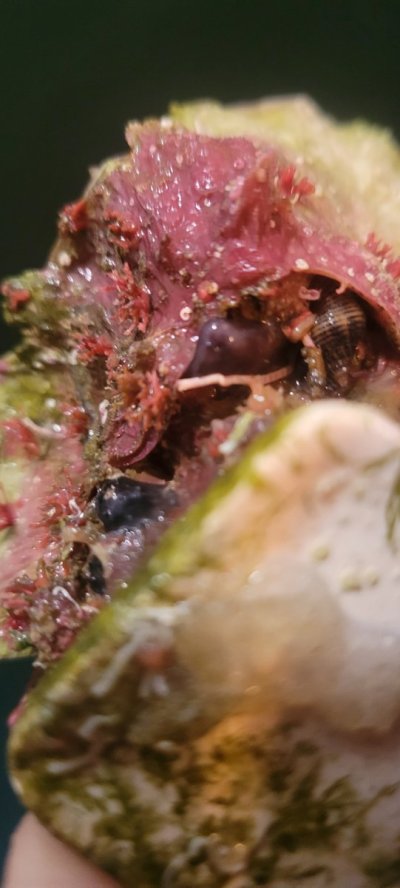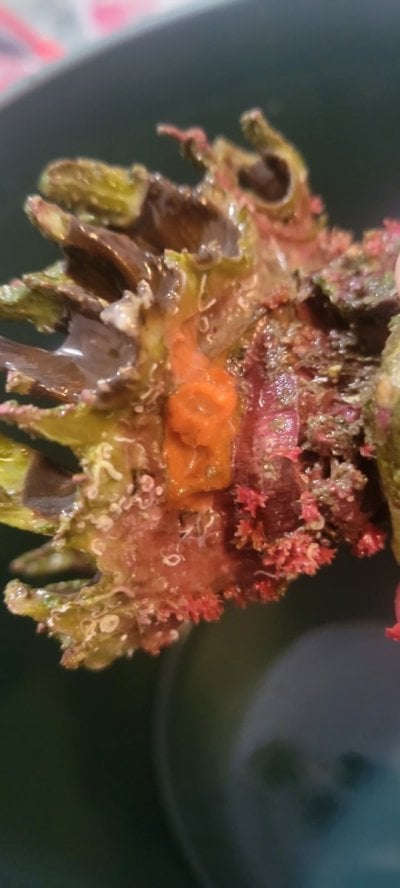Navigation
Install the app
How to install the app on iOS
Follow along with the video below to see how to install our site as a web app on your home screen.
Note: This feature may not be available in some browsers.
More options
You are using an out of date browser. It may not display this or other websites correctly.
You should upgrade or use an alternative browser.
You should upgrade or use an alternative browser.
First Colony underside
- Thread starter aminals
- Start date
- Tagged users None
There's a lot going on in these pics, so I'll cover what I can, but I'll probably miss something:
- The white squiggly worms I see are feather duster worm tubes and Spirorbid worm tubes (which are a kind of feather duster worm known for their little circle/spiral shells). These are harmless filter feeders.
- You have benthic foraminiferans (possibly Miniacina miniacea; see the links below) - also harmless filter feeders.
- The pink slimy stuff is probably either a sponge or cyanobacteria.
- The orange stuff is definitely a sponge (sponges are generally completely harmless filter feeders, but there a few rare exceptions).
- The black stuff may or may not be another sponge.
- There's a snail in the first pic (I don't know if that's the one you've removed or not).
Foraminifera – Earthling Nature
Posts about Foraminifera written by Piter Keo
Miniacina miniacea Red foraminiferan
Miniacina miniacea is commonly referred to as Red foraminiferan. Difficulty in the aquarium: There are no reports available yet that this animal has already been kept in captivity successfully. A aquarium size of at least 50 Liter is recommended. Toxicity: Toxic hazard unknown.
- There's a snail in the first pic (I don't know if that's the one you've removed or not).
The snail in the first pic looks suspiciously like a whelk... If it survived the dip and you kept it, a better photo might be necessary to identify it and determine if it's something you want in your tank.
Appreciate the detailed response. It's crazy how much life is on an old coral. When I untagged it a few amphipods ran down my arm.There's a lot going on in these pics, so I'll cover what I can, but I'll probably miss something:
- The white squiggly worms I see are feather duster worm tubes and Spirorbid worm tubes (which are a kind of feather duster worm known for their little circle/spiral shells). These are harmless filter feeders.
- You have benthic foraminiferans (possibly Miniacina miniacea; see the links below) - also harmless filter feeders.
- The pink slimy stuff is probably either a sponge or cyanobacteria.
- The orange stuff is definitely a sponge (sponges are generally completely harmless filter feeders, but there a few rare exceptions).
- The black stuff may or may not be another sponge.
- There's a snail in the first pic (I don't know if that's the one you've removed or not).

Foraminifera – Earthling Nature
Posts about Foraminifera written by Piter Keoearthlingnature.wordpress.com
Miniacina miniacea Red foraminiferan
Miniacina miniacea is commonly referred to as Red foraminiferan. Difficulty in the aquarium: There are no reports available yet that this animal has already been kept in captivity successfully. A aquarium size of at least 50 Liter is recommended. Toxicity: Toxic hazard unknown.www.reeflex.net
Snails dead but hopefully the foraminifera and sponges survived the 5minute dip and a little bitb of air.
Similar threads
- Replies
- 5
- Views
- 409
- Replies
- 9
- Views
- 245

















